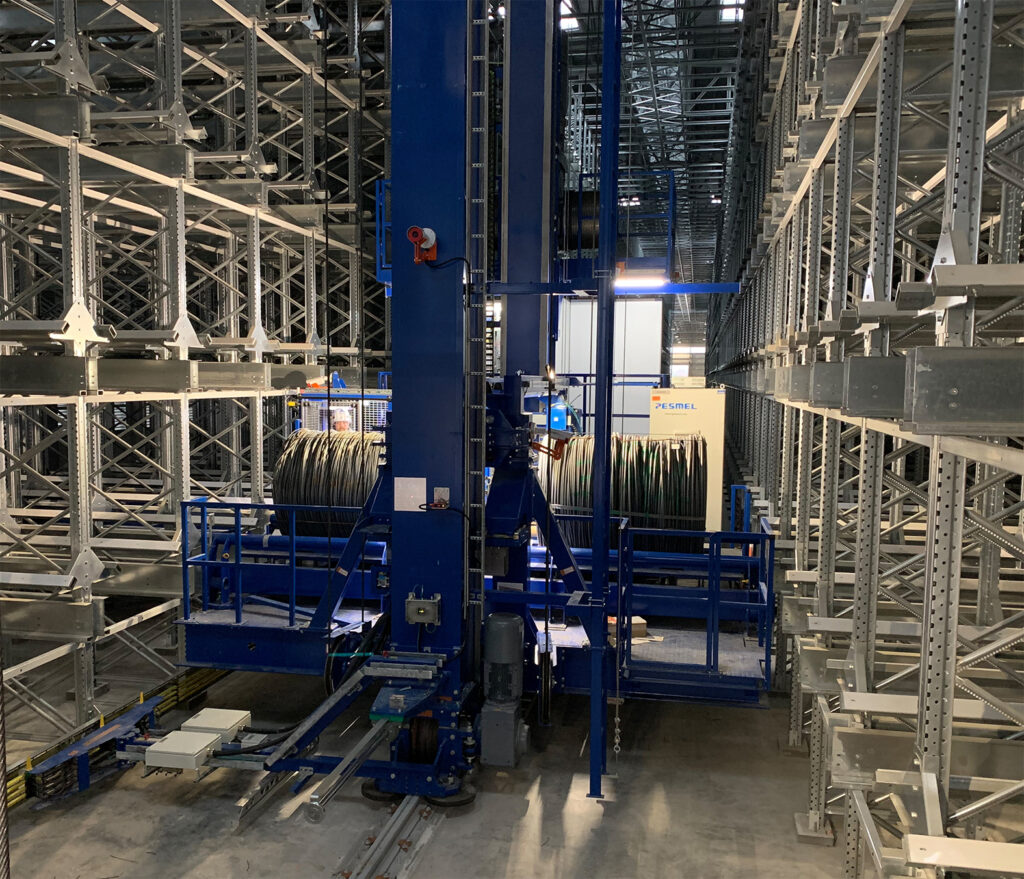In a greenfield wire rod mill in Northern Italy, a new high-bay storage system handles premium quality wire rod coils fully automatically day and night, seven days a week.
Udine-based Acciaierie Bertoli Safau SpA (ABS), a subsidiary of the Italian plant builder Danieli Group located in Northern Italy, is engaged in building an ultra-innovative wire rod that will set new standards in terms of production quality, technological innovation, and Industry 4.0. The mill, with a total of a EUR 200M investment, will serve as a state-of-the-art showroom for Danieli’s rolling mill equipment for their customers.
Investment driven by Industry 4.0 technologies
Upon start-up, the 500,000-ton capacity mill produces wire rod from steel billets, Roughly 150,000 tons of this capacity will be smaller high-end products destined for use in end user sectors like the automotive industry, which relies upon using high quality, critical components for car manufacturing. According to Stefano Scolari, CEO of ABS, the main objective of this new investment is the production of smaller dimension products ranging from 14mm in diameter down to 5,5mm that have not been produced by ABS earlier. The plant, which relies heavily upon Industry 4.0 technologies, is located in front of ABS’ Cargnacco headquarters and occupies roughly 150,000 square meters. The new wire rod storage is capable of accommodating 3,800 wire rod coils, each weighing three tons. The Pesmel system accommodates 11,400 tons of wire rod in total, representing roughly three to five weeks’ production at the plant.
Pesmel’s Warehouse Management System enables smooth material flows and storage efficiency.
State-of-the-art solution for wire rod handling
The aforementioned high-bay storage system, supplied by Pesmel of Finland, is designed to handle 150,000 tons of high-quality wire rod coils per year. The structure is controlled by the company’s proprietary Warehouse Management System (WMS) that enables smooth material flows and high storage efficiency. The storage system functions both as an intermediate store for coils going to annealing as well as despatch storage for customer deliveries using trucks and trains.
“My view of this project is that Danieli and ABS were brave enough and of the correct mindset to try something new that is reliant upon new technology,” comments Tony Leikas, CEO of Pesmel. “They wanted to implement new technology for wire rod handling.”
The core of the Pesmel system – the brain – is the WMS that is used to control the stacker cranes and warehouse logistics. It manages material flows between processes, optimizing storage and logistics functions, increasing the total system capacity, and decreasing operational costs. The high-bay storage system at ABS is a six-storey structure of racking for individual coils, dissected down the middle to accommodate three key items of equipment: sorting cars, stacker cranes, and channel vehicles. According to Pesmel, deep lane-type high-bay warehousing is cost-efficient because it needs fewer cranes than multi-aisle systems; typically two stacker cranes operate along a single aisle and transfer coils to racking to the left and right over the six storeys of available space.
Full traceability and gentle handling through automation
Steelmakers producing critical products for sectors like the automotive industry need to maintain product quality throughout the internal handling process at the plant. This means that gentle handling and full traceability are pre-requisites where in-plant logistics are concerned. In car manufacturing, having full traceability from billet through to end product is important from a safety perspective where critical components are concerned.

Full traceability can be secured more easily with a fully automated system.
Leikas claims that a fully automated system enables easy access to all coils regardless of storage position. Furthermore, a manual system reliant upon forklifts is always rougher on the product. When wire rod coils are stacked up to four high, there is pressure on the coils at the bottom. Operators don’t have immediate access to the lower coils and the traceability element of the process is questionable when compared with what a fully automated system can offer. The system’s full traceability function means that individual parts can be traced back through the process to the billet originally used to manufacture the wire rod.
Close cooperation in reaching joint goals
For ABS, the Pesmel system represents the future. It was optimised for the mill using simulation during the design phase.
“The software we write knows where the coil has to go and this is all programmed,” says Leikas, explaining how the system is unmanned, making the software a crucial element of the offering.
Danieli initially approached Pesmel to discuss the possibility of implementing a high-bay storage system at the ABS wire rod mill based on knowledge gathered from Pesmel’s steel customer references. Pesmel has supplied Danieli with packing lines before, notably for aluminum projects. Looking ahead, Leikas believes the next steps for Danieli/ABS could be both in the packing field to secure quality and in the development of auto-loading functions.
“On the software side the traceability exists, so adding functions to make the physical handling easier would make sense,” comments Pesmel CEO Tony Leikas comments.
“We believe that the new facility at ABS Udine represents the new normal of wire rod storing and logistics and, hence, will work in close cooperation with our customer to make it an excellent reference,” he concludes.